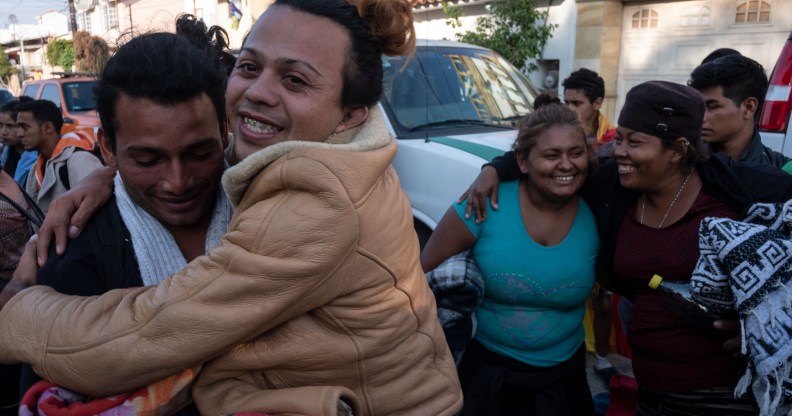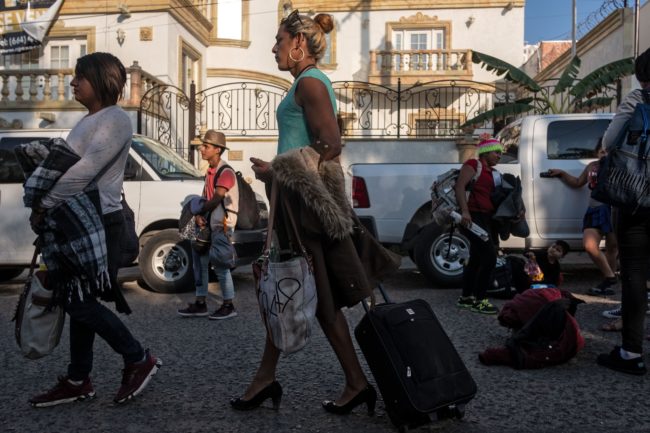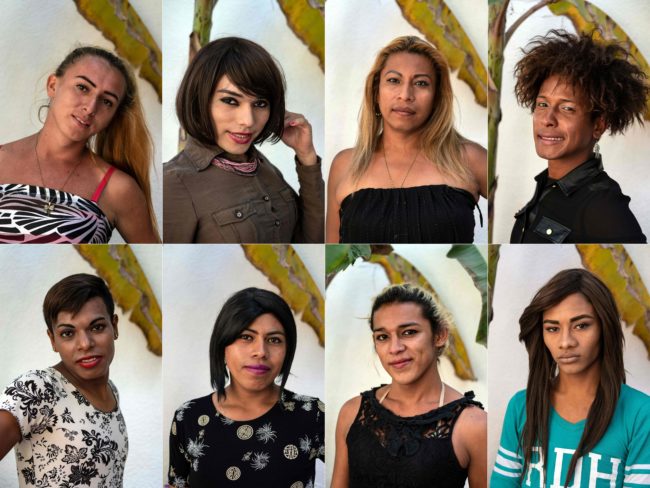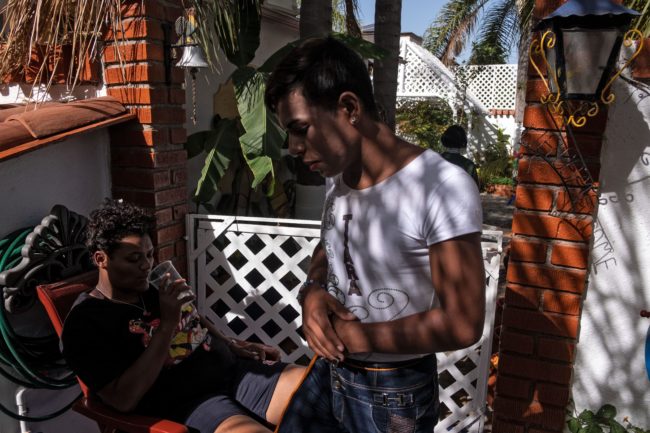LGBT asylum seekers survive caravan journey to US border

LGBT+ asylum seekers migrants celebrate their arrival in Tijuana, Mexico, on November 11, 2018. (Guillermo Arias/AFP/Getty)
tA group of LGBT+ asylum seekers were the first group out of the migrant caravan to reach the northern Mexico border.
Around 80 people arrived in the Mexican border city of Tijuana this week. The LGBT+ asylum seekers celebrated their safe arrival playing Ariana Grande music, according to The Washington Post.
“I cannot believe we actually made it here to the border,” Andy Albaringa, a 23-year-old trans woman from El Salvador, told the US publication. “The trip was so tiring.”
Members of the LGBT+ community broke off from the rest of the migrant caravan that has been travelling through Central America in the past month after facing discrimination along their journey.
LGBT+ Asylum seekers denounced discrimination from caravan members
César Mejía, a representative of the caravan’s LGBT+ asylum seekers, told Spanish news agency EFE they decided to rent private buses, with the support of LGBT+ rights groups, for the last stretch of the journey to avoid being sidelined.

LGBT+ asylum seekers migrants arrive in Tijuana, a step closer to the US border, on November 11, 2018. (Guillermo Arias/AFP/Getty)
“Bathing was a big problem, even when we wanted to shower there was no water. Same with food,” said the 23-year-old Honduran native, who fled after being beaten for being gay by local gang members.
Mejía said that while there had been no physical violence along the caravan journey, LGBT+ asylum seekers faced verbal abuse.
“People wouldn’t let us into trucks, they made us get in the back of the line for showers, they would call us ugly names,” Erick Dubon, who is also Honduran and was travelling with his boyfriend Pedro Nehemias, told The Washington Post.
Where do the LGBT+ asylum seekers come from?
The LGBT+ asylum seekers primarily travelled from Honduras, Guatemala, El Salvador and Nicaragua. They are fleeing poverty, violence and persecution based on their sexual orientation and gender identity.

Portraits of some of the 80 LGBT+ asylum seekers who travelled with the migrant caravan. (L-R, top to bottom) Honduran Mariela Ordonez, 22, Honduran Nati Venegas, 16, Salvadorean Britany Rachel, 36, Honduran Joana Stefani, 27, Honduran Alixon Maricela Rivera, 19, Honduran Lady Mejia, 23, Honduran Teresa Perez, 20, and Nicaraguan Sinai Cortez, 19, (Guillermo Arias/AFP/Getty)
The difficulties they encountered along the journey with the migrant caravan reminded some of them of the abuse faced in their home countries.
“They have denigrated us. Supposedly you’re emigrating from your country because of the violence, the discrimination, the homophobia, and it turns out that in the very caravan you face this kind of violence,” Lady Perez, a transgender woman from Honduras who fled the country after her boyfriend was killed, told the Associated Press.
“How are we supposed to know that someone among you won’t hurt us?”
— Nakai Flotte
The LGBT+ asylum seekers arrived in Tijuana waving a rainbow flag and taking accommodation in a home that, they said, was rented via Airbnb using their funds.
Tijuana Neighbours protest LGBT+ asylum seekers’ presence
But even there, local residents met them with suspicion and concerns that their presence would cause them trouble.
A heated exchange between the residents and the LGBT+ asylum seekers, represented by Mejía and transgender woman Nakai Flotte, was filmed by local news outlet Frontera.
“We aren’t safe here,” a woman living in the neighbourhood said, adding: “There could be someone within your group that could hurt us.”
“How are we supposed to know that someone among you won’t hurt us?” Flotte responded.

LGBT+ asylum seekers have rented accommodation in Tijuana. (Guillermo Arias/AFP/Getty)
As the discussion continued, one of the LGBT+ asylum seekers in the group unfolded the rainbow flag he had wrapped around him.
“That is the problem,” another local woman said. She pointed at the man and added: “It’s not necessary to go around with that flag.”
“We are not going to bother you. We are here, we are not going to bother anyone,” an exasperated Mejía responded, as he and Flotte gathered the LGBT+ asylum seekers backed into the house.

